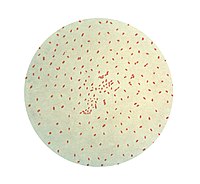
Photo from wikipedia
Multilocus sequence typing (MLST) provides allele-based characterization of bacterial pathogens in a standardized framework. However, classical MLST schemes for Bordetella pertussis, the causative agent of whooping cough, seldom reveal diversity… Click to show full abstract
Multilocus sequence typing (MLST) provides allele-based characterization of bacterial pathogens in a standardized framework. However, classical MLST schemes for Bordetella pertussis, the causative agent of whooping cough, seldom reveal diversity among the small number of gene targets and thereby fail to delineate population structure. ABSTRACT Multilocus sequence typing (MLST) provides allele-based characterization of bacterial pathogens in a standardized framework. However, classical MLST schemes for Bordetella pertussis, the causative agent of whooping cough, seldom reveal diversity among the small number of gene targets and thereby fail to delineate population structure. To improve the discriminatory power of allele-based molecular typing of B. pertussis, we have developed a whole-genome MLST (wgMLST) scheme from 225 reference-quality genome assemblies. Iterative refinement and allele curation resulted in a scheme of 3,506 coding sequences and covering 81.4% of the B. pertussis genome. This wgMLST scheme was further evaluated with data from a convenience sample of 2,389 B. pertussis isolates sequenced on Illumina instruments, including isolates from known outbreaks and epidemics previously characterized by existing molecular assays, as well as replicates collected from individual patients. wgMLST demonstrated concordance with whole-genome single nucleotide polymorphism (SNP) profiles, accurately resolved outbreak and sporadic cases in a retrospective comparison, and clustered replicate isolates collected from individual patients during diagnostic confirmation. Additionally, a reanalysis of isolates from two statewide epidemics using wgMLST reconstructed the population structures of circulating strains with increased resolution, revealing new clusters of related cases. Comparison with an existing core genome (cgMLST) scheme highlights the stable gene content of this bacterium and forms the initial foundation for necessary standardization. These results demonstrate the utility of wgMLST for improving B. pertussis characterization and genomic surveillance during the current pertussis disease resurgence.
Journal Title: Journal of Clinical Microbiology
Year Published: 2021
Link to full text (if available)
Share on Social Media: Sign Up to like & get
recommendations!